Intergenerational Trauma and Its Impact on Aboriginal Australians
VerifiedAdded on 2022/09/15
|7
|2089
|12
Essay
AI Summary
This essay delves into the pervasive issue of intergenerational trauma affecting Aboriginal and Torres Strait Islander Australians. It begins by defining trauma and intergenerational trauma, highlighting how it is passed down through generations via parenting practices, violence, and mental health problems, with a specific focus on the devastating effects experienced by Indigenous communities due to colonization. The essay uses current statistics to illustrate the burden of this health issue for Aboriginal Australians compared to non-Aboriginal Australians, highlighting the high rates of psychological distress and self-destructive behaviors. It then describes how the history of colonization, including violence, loss of culture, and policies like the mandatory removal of children, has significantly contributed to the development of this trauma. The essay also identifies and discusses the impact of social determinants of health, such as childhood experiences and social exclusion, on the progression of intergenerational trauma, emphasizing how these factors can undermine the well-being of individuals and communities. The analysis considers the marginalization of Aboriginal women and the cultural trauma caused by the destruction of Aboriginal laws and social structures. The essay concludes by emphasizing the need for societal understanding and support to help affected families manage intergenerational trauma and build a brighter future.
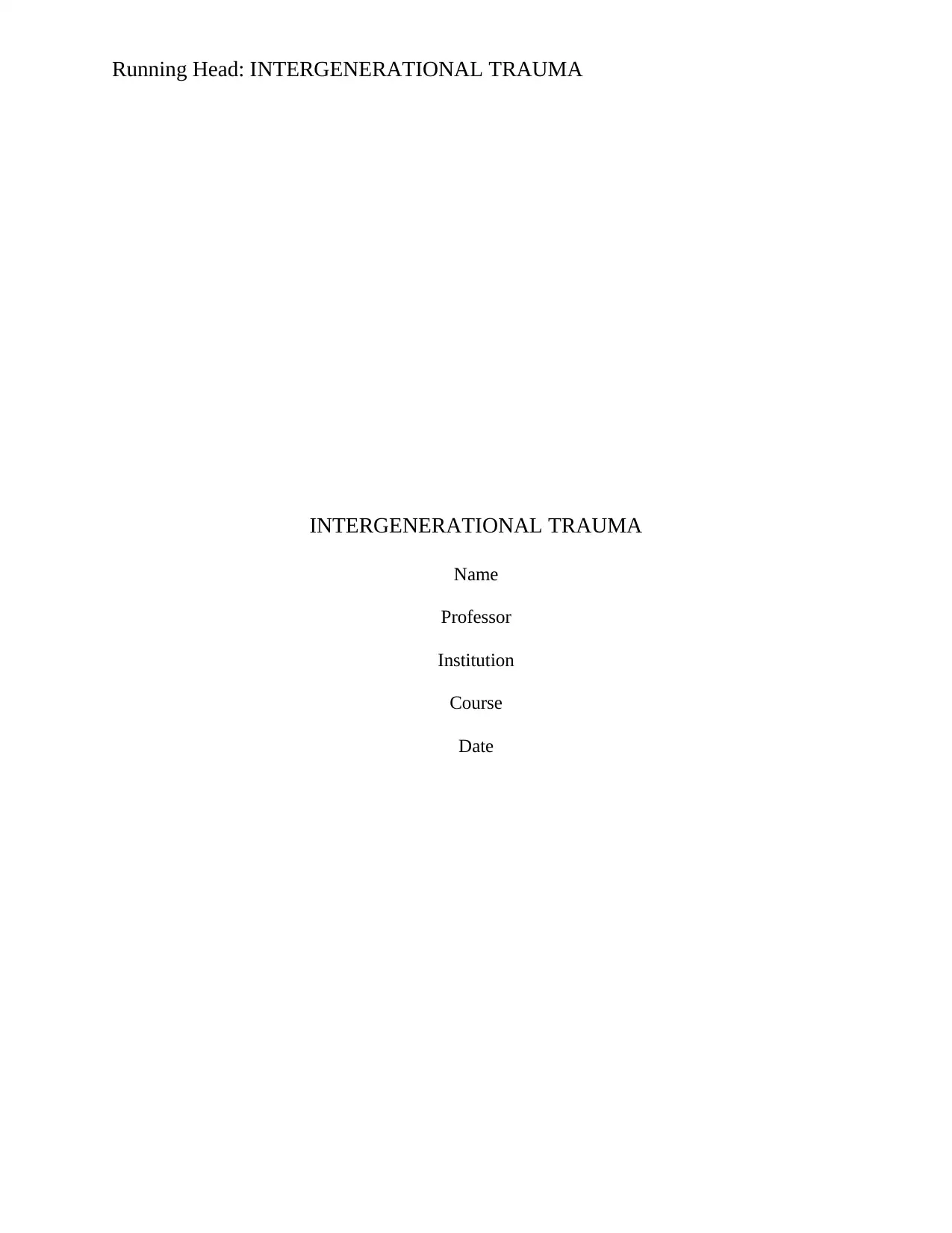
Running Head: INTERGENERATIONAL TRAUMA
INTERGENERATIONAL TRAUMA
Name
Professor
Institution
Course
Date
INTERGENERATIONAL TRAUMA
Name
Professor
Institution
Course
Date
Paraphrase This Document
Need a fresh take? Get an instant paraphrase of this document with our AI Paraphraser
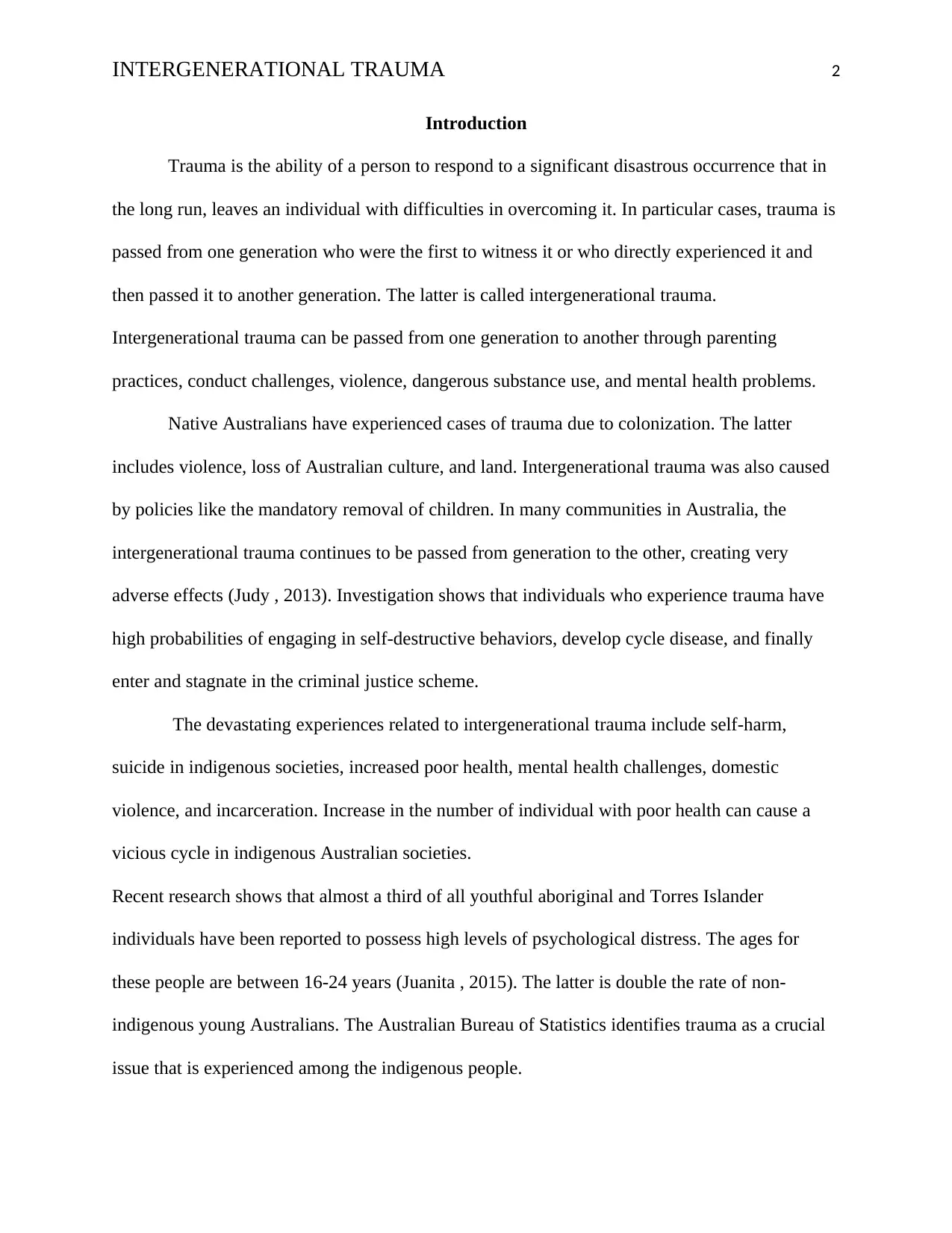
INTERGENERATIONAL TRAUMA 2
Introduction
Trauma is the ability of a person to respond to a significant disastrous occurrence that in
the long run, leaves an individual with difficulties in overcoming it. In particular cases, trauma is
passed from one generation who were the first to witness it or who directly experienced it and
then passed it to another generation. The latter is called intergenerational trauma.
Intergenerational trauma can be passed from one generation to another through parenting
practices, conduct challenges, violence, dangerous substance use, and mental health problems.
Native Australians have experienced cases of trauma due to colonization. The latter
includes violence, loss of Australian culture, and land. Intergenerational trauma was also caused
by policies like the mandatory removal of children. In many communities in Australia, the
intergenerational trauma continues to be passed from generation to the other, creating very
adverse effects (Judy , 2013). Investigation shows that individuals who experience trauma have
high probabilities of engaging in self-destructive behaviors, develop cycle disease, and finally
enter and stagnate in the criminal justice scheme.
The devastating experiences related to intergenerational trauma include self-harm,
suicide in indigenous societies, increased poor health, mental health challenges, domestic
violence, and incarceration. Increase in the number of individual with poor health can cause a
vicious cycle in indigenous Australian societies.
Recent research shows that almost a third of all youthful aboriginal and Torres Islander
individuals have been reported to possess high levels of psychological distress. The ages for
these people are between 16-24 years (Juanita , 2015). The latter is double the rate of non-
indigenous young Australians. The Australian Bureau of Statistics identifies trauma as a crucial
issue that is experienced among the indigenous people.
Introduction
Trauma is the ability of a person to respond to a significant disastrous occurrence that in
the long run, leaves an individual with difficulties in overcoming it. In particular cases, trauma is
passed from one generation who were the first to witness it or who directly experienced it and
then passed it to another generation. The latter is called intergenerational trauma.
Intergenerational trauma can be passed from one generation to another through parenting
practices, conduct challenges, violence, dangerous substance use, and mental health problems.
Native Australians have experienced cases of trauma due to colonization. The latter
includes violence, loss of Australian culture, and land. Intergenerational trauma was also caused
by policies like the mandatory removal of children. In many communities in Australia, the
intergenerational trauma continues to be passed from generation to the other, creating very
adverse effects (Judy , 2013). Investigation shows that individuals who experience trauma have
high probabilities of engaging in self-destructive behaviors, develop cycle disease, and finally
enter and stagnate in the criminal justice scheme.
The devastating experiences related to intergenerational trauma include self-harm,
suicide in indigenous societies, increased poor health, mental health challenges, domestic
violence, and incarceration. Increase in the number of individual with poor health can cause a
vicious cycle in indigenous Australian societies.
Recent research shows that almost a third of all youthful aboriginal and Torres Islander
individuals have been reported to possess high levels of psychological distress. The ages for
these people are between 16-24 years (Juanita , 2015). The latter is double the rate of non-
indigenous young Australians. The Australian Bureau of Statistics identifies trauma as a crucial
issue that is experienced among the indigenous people.
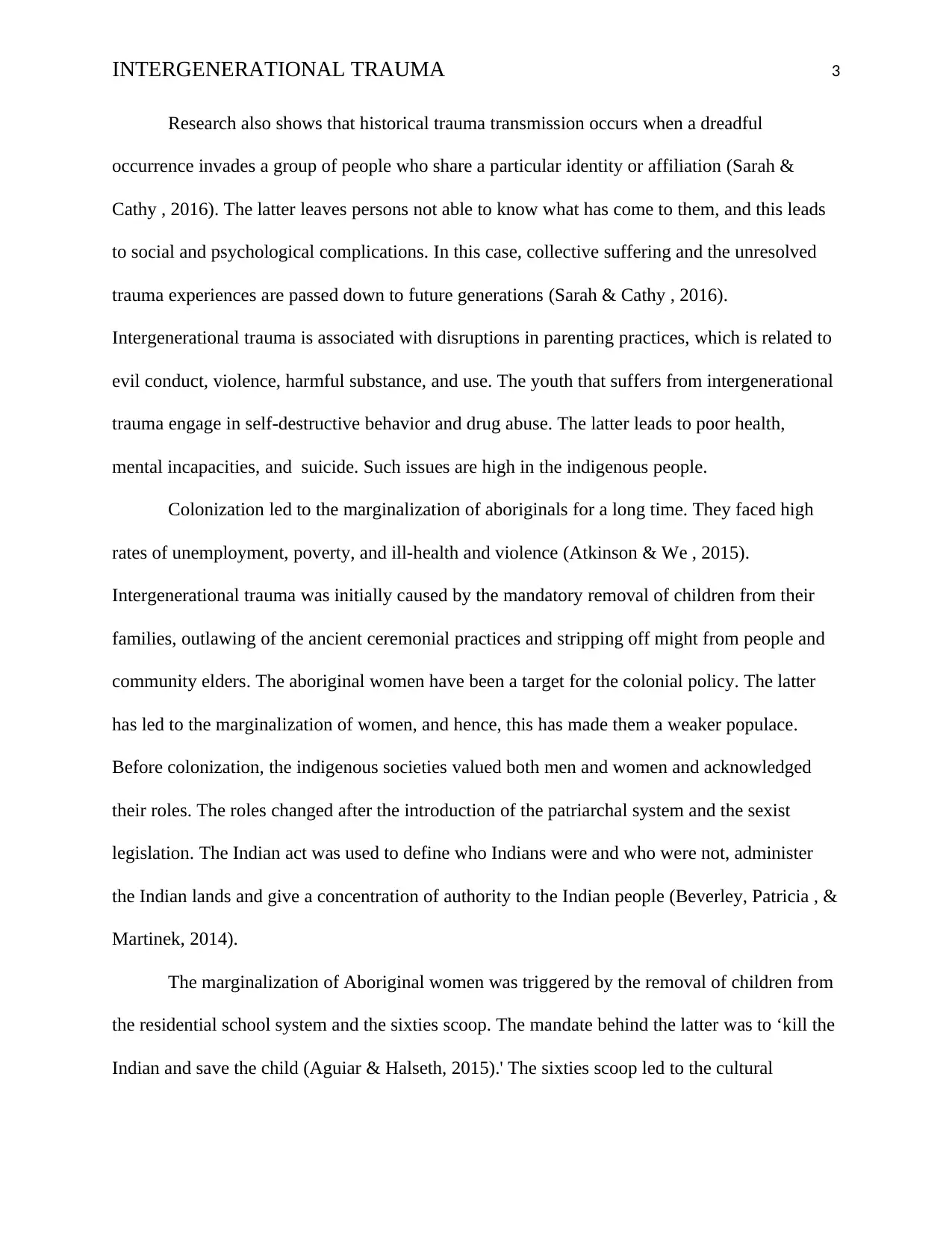
INTERGENERATIONAL TRAUMA 3
Research also shows that historical trauma transmission occurs when a dreadful
occurrence invades a group of people who share a particular identity or affiliation (Sarah &
Cathy , 2016). The latter leaves persons not able to know what has come to them, and this leads
to social and psychological complications. In this case, collective suffering and the unresolved
trauma experiences are passed down to future generations (Sarah & Cathy , 2016).
Intergenerational trauma is associated with disruptions in parenting practices, which is related to
evil conduct, violence, harmful substance, and use. The youth that suffers from intergenerational
trauma engage in self-destructive behavior and drug abuse. The latter leads to poor health,
mental incapacities, and suicide. Such issues are high in the indigenous people.
Colonization led to the marginalization of aboriginals for a long time. They faced high
rates of unemployment, poverty, and ill-health and violence (Atkinson & We , 2015).
Intergenerational trauma was initially caused by the mandatory removal of children from their
families, outlawing of the ancient ceremonial practices and stripping off might from people and
community elders. The aboriginal women have been a target for the colonial policy. The latter
has led to the marginalization of women, and hence, this has made them a weaker populace.
Before colonization, the indigenous societies valued both men and women and acknowledged
their roles. The roles changed after the introduction of the patriarchal system and the sexist
legislation. The Indian act was used to define who Indians were and who were not, administer
the Indian lands and give a concentration of authority to the Indian people (Beverley, Patricia , &
Martinek, 2014).
The marginalization of Aboriginal women was triggered by the removal of children from
the residential school system and the sixties scoop. The mandate behind the latter was to ‘kill the
Indian and save the child (Aguiar & Halseth, 2015).' The sixties scoop led to the cultural
Research also shows that historical trauma transmission occurs when a dreadful
occurrence invades a group of people who share a particular identity or affiliation (Sarah &
Cathy , 2016). The latter leaves persons not able to know what has come to them, and this leads
to social and psychological complications. In this case, collective suffering and the unresolved
trauma experiences are passed down to future generations (Sarah & Cathy , 2016).
Intergenerational trauma is associated with disruptions in parenting practices, which is related to
evil conduct, violence, harmful substance, and use. The youth that suffers from intergenerational
trauma engage in self-destructive behavior and drug abuse. The latter leads to poor health,
mental incapacities, and suicide. Such issues are high in the indigenous people.
Colonization led to the marginalization of aboriginals for a long time. They faced high
rates of unemployment, poverty, and ill-health and violence (Atkinson & We , 2015).
Intergenerational trauma was initially caused by the mandatory removal of children from their
families, outlawing of the ancient ceremonial practices and stripping off might from people and
community elders. The aboriginal women have been a target for the colonial policy. The latter
has led to the marginalization of women, and hence, this has made them a weaker populace.
Before colonization, the indigenous societies valued both men and women and acknowledged
their roles. The roles changed after the introduction of the patriarchal system and the sexist
legislation. The Indian act was used to define who Indians were and who were not, administer
the Indian lands and give a concentration of authority to the Indian people (Beverley, Patricia , &
Martinek, 2014).
The marginalization of Aboriginal women was triggered by the removal of children from
the residential school system and the sixties scoop. The mandate behind the latter was to ‘kill the
Indian and save the child (Aguiar & Halseth, 2015).' The sixties scoop led to the cultural
⊘ This is a preview!⊘
Do you want full access?
Subscribe today to unlock all pages.

Trusted by 1+ million students worldwide
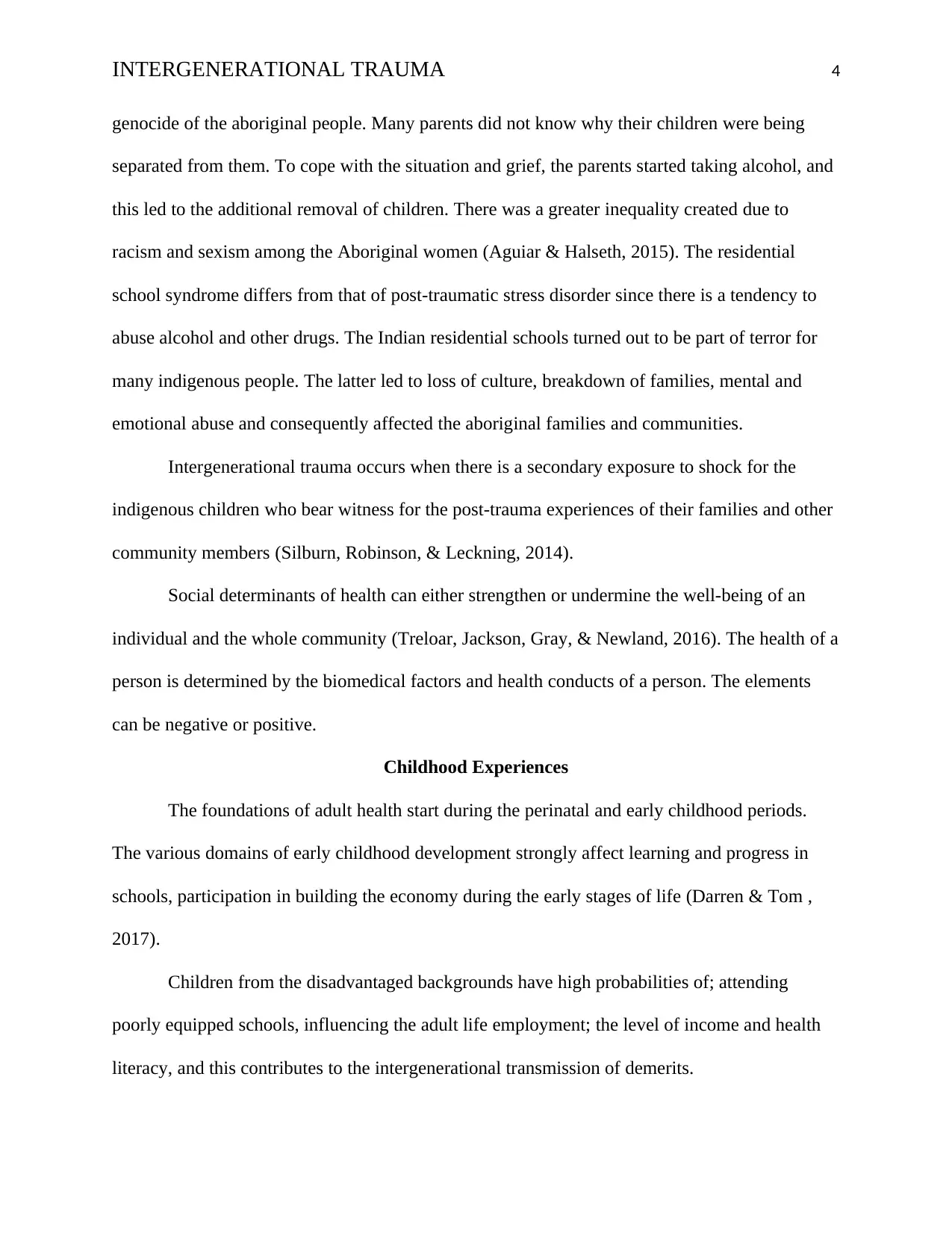
INTERGENERATIONAL TRAUMA 4
genocide of the aboriginal people. Many parents did not know why their children were being
separated from them. To cope with the situation and grief, the parents started taking alcohol, and
this led to the additional removal of children. There was a greater inequality created due to
racism and sexism among the Aboriginal women (Aguiar & Halseth, 2015). The residential
school syndrome differs from that of post-traumatic stress disorder since there is a tendency to
abuse alcohol and other drugs. The Indian residential schools turned out to be part of terror for
many indigenous people. The latter led to loss of culture, breakdown of families, mental and
emotional abuse and consequently affected the aboriginal families and communities.
Intergenerational trauma occurs when there is a secondary exposure to shock for the
indigenous children who bear witness for the post-trauma experiences of their families and other
community members (Silburn, Robinson, & Leckning, 2014).
Social determinants of health can either strengthen or undermine the well-being of an
individual and the whole community (Treloar, Jackson, Gray, & Newland, 2016). The health of a
person is determined by the biomedical factors and health conducts of a person. The elements
can be negative or positive.
Childhood Experiences
The foundations of adult health start during the perinatal and early childhood periods.
The various domains of early childhood development strongly affect learning and progress in
schools, participation in building the economy during the early stages of life (Darren & Tom ,
2017).
Children from the disadvantaged backgrounds have high probabilities of; attending
poorly equipped schools, influencing the adult life employment; the level of income and health
literacy, and this contributes to the intergenerational transmission of demerits.
genocide of the aboriginal people. Many parents did not know why their children were being
separated from them. To cope with the situation and grief, the parents started taking alcohol, and
this led to the additional removal of children. There was a greater inequality created due to
racism and sexism among the Aboriginal women (Aguiar & Halseth, 2015). The residential
school syndrome differs from that of post-traumatic stress disorder since there is a tendency to
abuse alcohol and other drugs. The Indian residential schools turned out to be part of terror for
many indigenous people. The latter led to loss of culture, breakdown of families, mental and
emotional abuse and consequently affected the aboriginal families and communities.
Intergenerational trauma occurs when there is a secondary exposure to shock for the
indigenous children who bear witness for the post-trauma experiences of their families and other
community members (Silburn, Robinson, & Leckning, 2014).
Social determinants of health can either strengthen or undermine the well-being of an
individual and the whole community (Treloar, Jackson, Gray, & Newland, 2016). The health of a
person is determined by the biomedical factors and health conducts of a person. The elements
can be negative or positive.
Childhood Experiences
The foundations of adult health start during the perinatal and early childhood periods.
The various domains of early childhood development strongly affect learning and progress in
schools, participation in building the economy during the early stages of life (Darren & Tom ,
2017).
Children from the disadvantaged backgrounds have high probabilities of; attending
poorly equipped schools, influencing the adult life employment; the level of income and health
literacy, and this contributes to the intergenerational transmission of demerits.
Paraphrase This Document
Need a fresh take? Get an instant paraphrase of this document with our AI Paraphraser
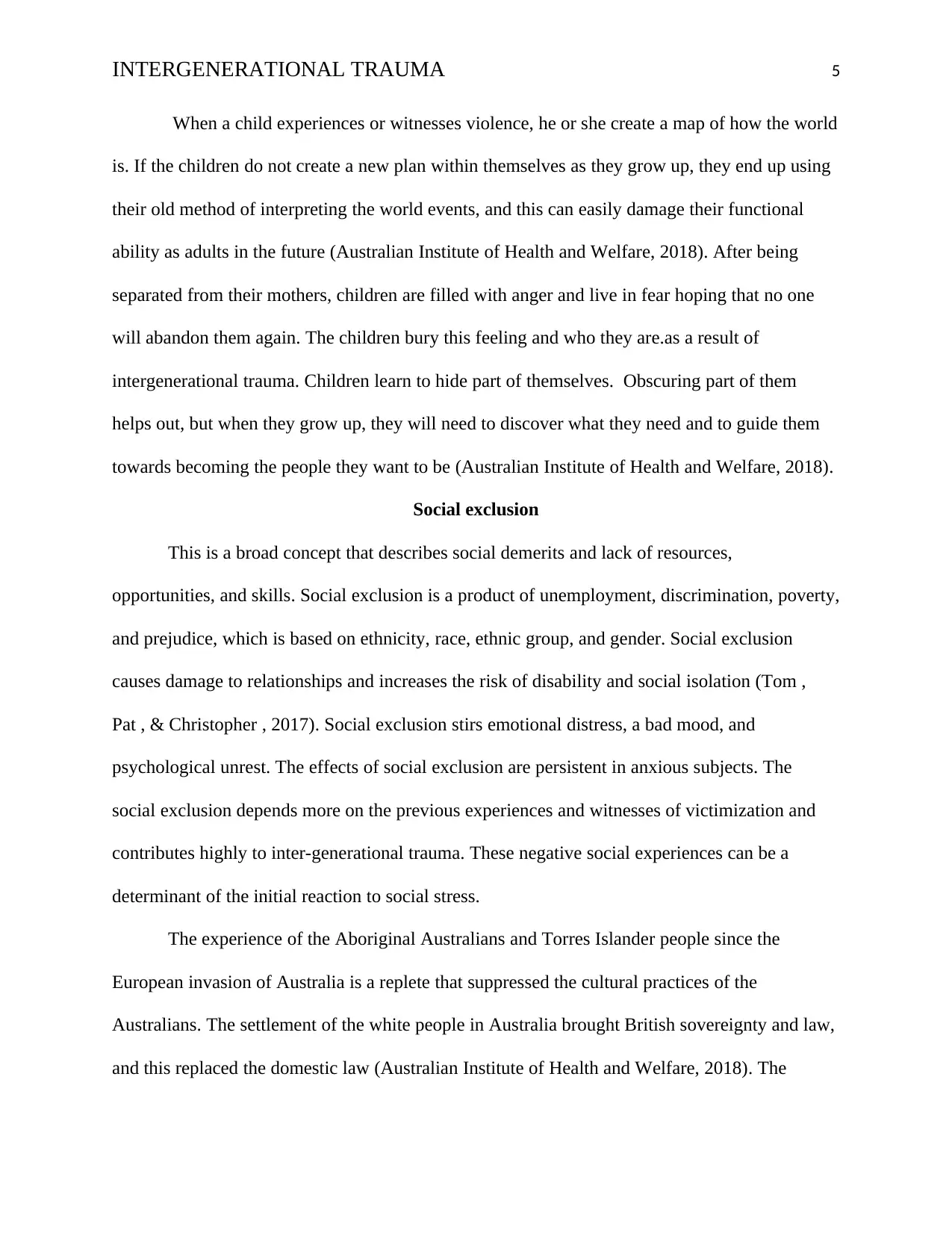
INTERGENERATIONAL TRAUMA 5
When a child experiences or witnesses violence, he or she create a map of how the world
is. If the children do not create a new plan within themselves as they grow up, they end up using
their old method of interpreting the world events, and this can easily damage their functional
ability as adults in the future (Australian Institute of Health and Welfare, 2018). After being
separated from their mothers, children are filled with anger and live in fear hoping that no one
will abandon them again. The children bury this feeling and who they are.as a result of
intergenerational trauma. Children learn to hide part of themselves. Obscuring part of them
helps out, but when they grow up, they will need to discover what they need and to guide them
towards becoming the people they want to be (Australian Institute of Health and Welfare, 2018).
Social exclusion
This is a broad concept that describes social demerits and lack of resources,
opportunities, and skills. Social exclusion is a product of unemployment, discrimination, poverty,
and prejudice, which is based on ethnicity, race, ethnic group, and gender. Social exclusion
causes damage to relationships and increases the risk of disability and social isolation (Tom ,
Pat , & Christopher , 2017). Social exclusion stirs emotional distress, a bad mood, and
psychological unrest. The effects of social exclusion are persistent in anxious subjects. The
social exclusion depends more on the previous experiences and witnesses of victimization and
contributes highly to inter-generational trauma. These negative social experiences can be a
determinant of the initial reaction to social stress.
The experience of the Aboriginal Australians and Torres Islander people since the
European invasion of Australia is a replete that suppressed the cultural practices of the
Australians. The settlement of the white people in Australia brought British sovereignty and law,
and this replaced the domestic law (Australian Institute of Health and Welfare, 2018). The
When a child experiences or witnesses violence, he or she create a map of how the world
is. If the children do not create a new plan within themselves as they grow up, they end up using
their old method of interpreting the world events, and this can easily damage their functional
ability as adults in the future (Australian Institute of Health and Welfare, 2018). After being
separated from their mothers, children are filled with anger and live in fear hoping that no one
will abandon them again. The children bury this feeling and who they are.as a result of
intergenerational trauma. Children learn to hide part of themselves. Obscuring part of them
helps out, but when they grow up, they will need to discover what they need and to guide them
towards becoming the people they want to be (Australian Institute of Health and Welfare, 2018).
Social exclusion
This is a broad concept that describes social demerits and lack of resources,
opportunities, and skills. Social exclusion is a product of unemployment, discrimination, poverty,
and prejudice, which is based on ethnicity, race, ethnic group, and gender. Social exclusion
causes damage to relationships and increases the risk of disability and social isolation (Tom ,
Pat , & Christopher , 2017). Social exclusion stirs emotional distress, a bad mood, and
psychological unrest. The effects of social exclusion are persistent in anxious subjects. The
social exclusion depends more on the previous experiences and witnesses of victimization and
contributes highly to inter-generational trauma. These negative social experiences can be a
determinant of the initial reaction to social stress.
The experience of the Aboriginal Australians and Torres Islander people since the
European invasion of Australia is a replete that suppressed the cultural practices of the
Australians. The settlement of the white people in Australia brought British sovereignty and law,
and this replaced the domestic law (Australian Institute of Health and Welfare, 2018). The
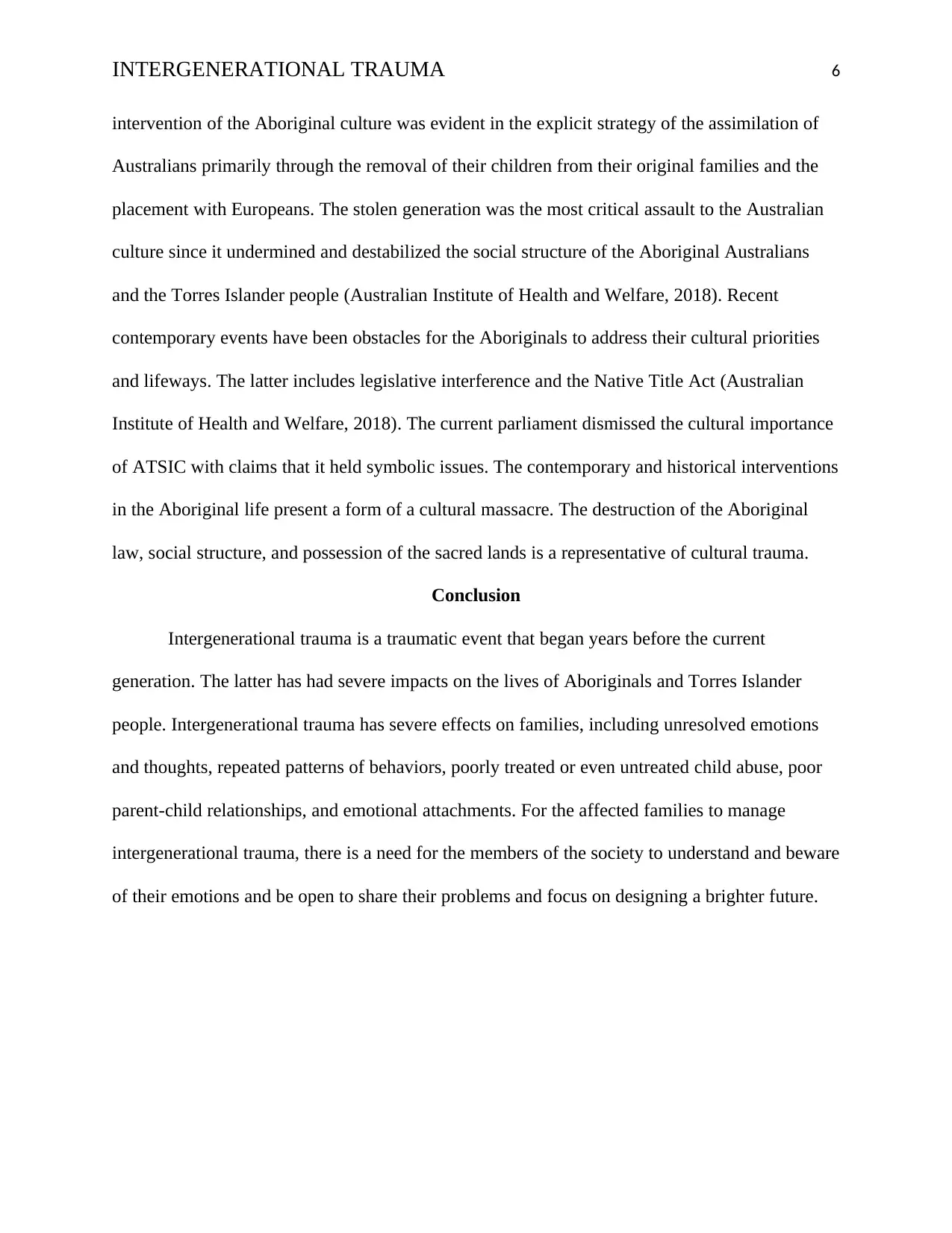
INTERGENERATIONAL TRAUMA 6
intervention of the Aboriginal culture was evident in the explicit strategy of the assimilation of
Australians primarily through the removal of their children from their original families and the
placement with Europeans. The stolen generation was the most critical assault to the Australian
culture since it undermined and destabilized the social structure of the Aboriginal Australians
and the Torres Islander people (Australian Institute of Health and Welfare, 2018). Recent
contemporary events have been obstacles for the Aboriginals to address their cultural priorities
and lifeways. The latter includes legislative interference and the Native Title Act (Australian
Institute of Health and Welfare, 2018). The current parliament dismissed the cultural importance
of ATSIC with claims that it held symbolic issues. The contemporary and historical interventions
in the Aboriginal life present a form of a cultural massacre. The destruction of the Aboriginal
law, social structure, and possession of the sacred lands is a representative of cultural trauma.
Conclusion
Intergenerational trauma is a traumatic event that began years before the current
generation. The latter has had severe impacts on the lives of Aboriginals and Torres Islander
people. Intergenerational trauma has severe effects on families, including unresolved emotions
and thoughts, repeated patterns of behaviors, poorly treated or even untreated child abuse, poor
parent-child relationships, and emotional attachments. For the affected families to manage
intergenerational trauma, there is a need for the members of the society to understand and beware
of their emotions and be open to share their problems and focus on designing a brighter future.
intervention of the Aboriginal culture was evident in the explicit strategy of the assimilation of
Australians primarily through the removal of their children from their original families and the
placement with Europeans. The stolen generation was the most critical assault to the Australian
culture since it undermined and destabilized the social structure of the Aboriginal Australians
and the Torres Islander people (Australian Institute of Health and Welfare, 2018). Recent
contemporary events have been obstacles for the Aboriginals to address their cultural priorities
and lifeways. The latter includes legislative interference and the Native Title Act (Australian
Institute of Health and Welfare, 2018). The current parliament dismissed the cultural importance
of ATSIC with claims that it held symbolic issues. The contemporary and historical interventions
in the Aboriginal life present a form of a cultural massacre. The destruction of the Aboriginal
law, social structure, and possession of the sacred lands is a representative of cultural trauma.
Conclusion
Intergenerational trauma is a traumatic event that began years before the current
generation. The latter has had severe impacts on the lives of Aboriginals and Torres Islander
people. Intergenerational trauma has severe effects on families, including unresolved emotions
and thoughts, repeated patterns of behaviors, poorly treated or even untreated child abuse, poor
parent-child relationships, and emotional attachments. For the affected families to manage
intergenerational trauma, there is a need for the members of the society to understand and beware
of their emotions and be open to share their problems and focus on designing a brighter future.
⊘ This is a preview!⊘
Do you want full access?
Subscribe today to unlock all pages.

Trusted by 1+ million students worldwide
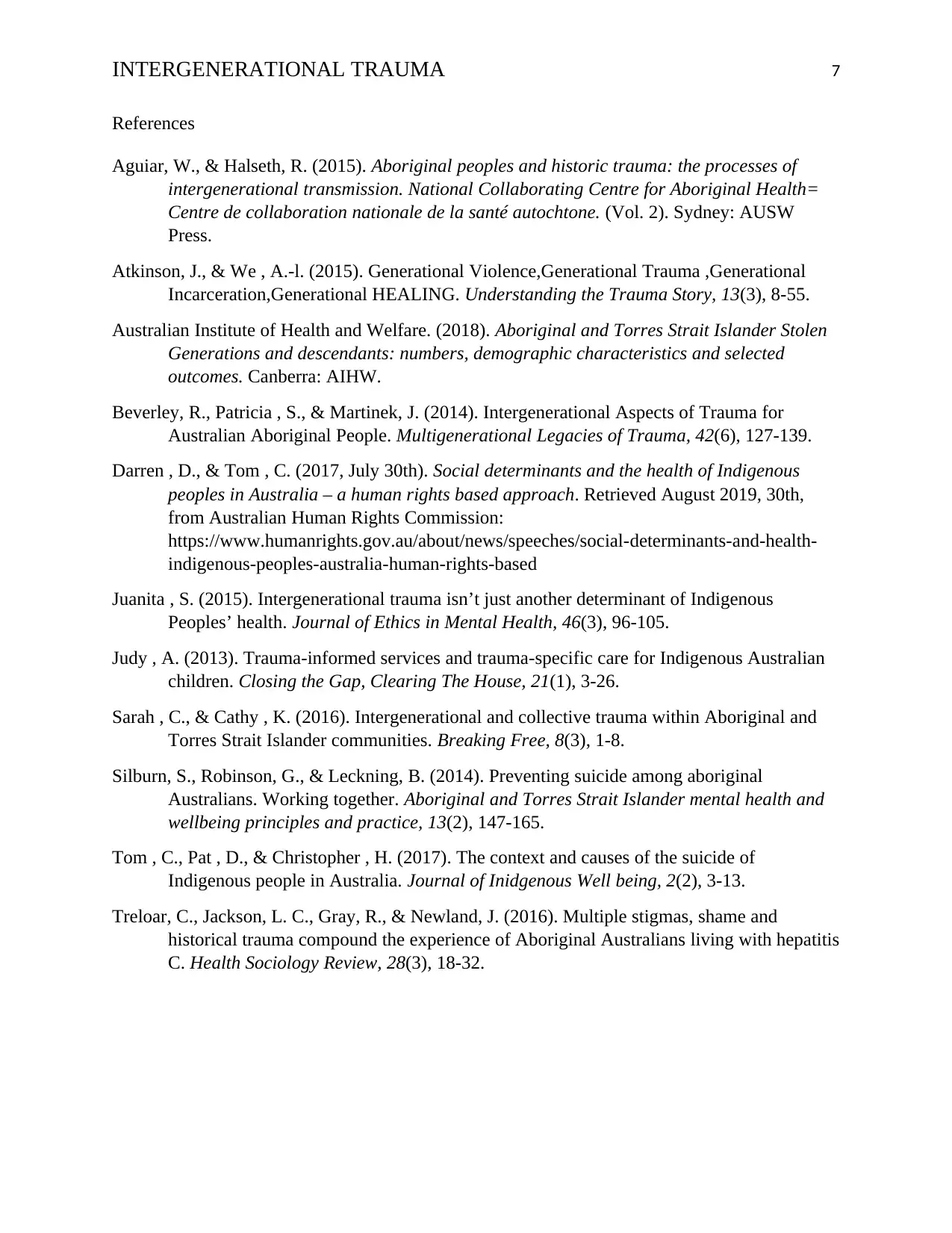
INTERGENERATIONAL TRAUMA 7
References
Aguiar, W., & Halseth, R. (2015). Aboriginal peoples and historic trauma: the processes of
intergenerational transmission. National Collaborating Centre for Aboriginal Health=
Centre de collaboration nationale de la santé autochtone. (Vol. 2). Sydney: AUSW
Press.
Atkinson, J., & We , A.-l. (2015). Generational Violence,Generational Trauma ,Generational
Incarceration,Generational HEALING. Understanding the Trauma Story, 13(3), 8-55.
Australian Institute of Health and Welfare. (2018). Aboriginal and Torres Strait Islander Stolen
Generations and descendants: numbers, demographic characteristics and selected
outcomes. Canberra: AIHW.
Beverley, R., Patricia , S., & Martinek, J. (2014). Intergenerational Aspects of Trauma for
Australian Aboriginal People. Multigenerational Legacies of Trauma, 42(6), 127-139.
Darren , D., & Tom , C. (2017, July 30th). Social determinants and the health of Indigenous
peoples in Australia – a human rights based approach. Retrieved August 2019, 30th,
from Australian Human Rights Commission:
https://www.humanrights.gov.au/about/news/speeches/social-determinants-and-health-
indigenous-peoples-australia-human-rights-based
Juanita , S. (2015). Intergenerational trauma isn’t just another determinant of Indigenous
Peoples’ health. Journal of Ethics in Mental Health, 46(3), 96-105.
Judy , A. (2013). Trauma-informed services and trauma-specific care for Indigenous Australian
children. Closing the Gap, Clearing The House, 21(1), 3-26.
Sarah , C., & Cathy , K. (2016). Intergenerational and collective trauma within Aboriginal and
Torres Strait Islander communities. Breaking Free, 8(3), 1-8.
Silburn, S., Robinson, G., & Leckning, B. (2014). Preventing suicide among aboriginal
Australians. Working together. Aboriginal and Torres Strait Islander mental health and
wellbeing principles and practice, 13(2), 147-165.
Tom , C., Pat , D., & Christopher , H. (2017). The context and causes of the suicide of
Indigenous people in Australia. Journal of Inidgenous Well being, 2(2), 3-13.
Treloar, C., Jackson, L. C., Gray, R., & Newland, J. (2016). Multiple stigmas, shame and
historical trauma compound the experience of Aboriginal Australians living with hepatitis
C. Health Sociology Review, 28(3), 18-32.
References
Aguiar, W., & Halseth, R. (2015). Aboriginal peoples and historic trauma: the processes of
intergenerational transmission. National Collaborating Centre for Aboriginal Health=
Centre de collaboration nationale de la santé autochtone. (Vol. 2). Sydney: AUSW
Press.
Atkinson, J., & We , A.-l. (2015). Generational Violence,Generational Trauma ,Generational
Incarceration,Generational HEALING. Understanding the Trauma Story, 13(3), 8-55.
Australian Institute of Health and Welfare. (2018). Aboriginal and Torres Strait Islander Stolen
Generations and descendants: numbers, demographic characteristics and selected
outcomes. Canberra: AIHW.
Beverley, R., Patricia , S., & Martinek, J. (2014). Intergenerational Aspects of Trauma for
Australian Aboriginal People. Multigenerational Legacies of Trauma, 42(6), 127-139.
Darren , D., & Tom , C. (2017, July 30th). Social determinants and the health of Indigenous
peoples in Australia – a human rights based approach. Retrieved August 2019, 30th,
from Australian Human Rights Commission:
https://www.humanrights.gov.au/about/news/speeches/social-determinants-and-health-
indigenous-peoples-australia-human-rights-based
Juanita , S. (2015). Intergenerational trauma isn’t just another determinant of Indigenous
Peoples’ health. Journal of Ethics in Mental Health, 46(3), 96-105.
Judy , A. (2013). Trauma-informed services and trauma-specific care for Indigenous Australian
children. Closing the Gap, Clearing The House, 21(1), 3-26.
Sarah , C., & Cathy , K. (2016). Intergenerational and collective trauma within Aboriginal and
Torres Strait Islander communities. Breaking Free, 8(3), 1-8.
Silburn, S., Robinson, G., & Leckning, B. (2014). Preventing suicide among aboriginal
Australians. Working together. Aboriginal and Torres Strait Islander mental health and
wellbeing principles and practice, 13(2), 147-165.
Tom , C., Pat , D., & Christopher , H. (2017). The context and causes of the suicide of
Indigenous people in Australia. Journal of Inidgenous Well being, 2(2), 3-13.
Treloar, C., Jackson, L. C., Gray, R., & Newland, J. (2016). Multiple stigmas, shame and
historical trauma compound the experience of Aboriginal Australians living with hepatitis
C. Health Sociology Review, 28(3), 18-32.
1 out of 7
Related Documents
Your All-in-One AI-Powered Toolkit for Academic Success.
+13062052269
info@desklib.com
Available 24*7 on WhatsApp / Email
![[object Object]](/_next/static/media/star-bottom.7253800d.svg)
Unlock your academic potential
Copyright © 2020–2025 A2Z Services. All Rights Reserved. Developed and managed by ZUCOL.




